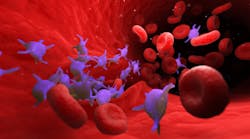To take the test online go HERE. For more information, visit the Continuing Education tab.
LEARNING OBJECTIVES
Upon completion of this article, the reader will be able to:
1. Discuss the need for a quality management system (QMS) in point-of-care testing (POCT).
2. List the quality system essentials that are recommended for a laboratory QMS.
3. Describe how each quality system essential can be applied to a POCT program.
4. Differentiate between quality assurance (QA) and quality control (QC).
In the Continuing Education article in the April 2023 issue of MLO, laboratory quality management systems were discussed and details provided on each component.1 When it comes to maintaining quality in point-of-care testing (POCT), we are often presented with very different sets of challenges than our laboratory counterparts. While POCT is subject to the same CLIA regulations, minimal guidance is offered on how to meet those needs in POCT systems. One challenge is that testing personnel who perform POCT are non-laboratorians, meaning that some of the guidance available may not be written in language that non-laboratorian staff can easily understand. Another is that POCT is performed in a variety of settings that can include hospital units, ambulatory sites such as doctors’ offices, and a variety of other settings. A final challenge is understanding local, state, and/or federal laboratory regulations. Laboratory staff will have a basic understanding of regulations through schooling and on-the-job training, however, clinical staff whose background and training is strictly focused on patient care, may not have the same knowledge of these requirements.
When setting quality standards in POCT, no national standards exist for quality improvement management. The most common metrics measured for improvement across POCT systems include patient identification (ID) errors, ID limit errors, specimen collection errors, and manual test result entry errors. As stated in the July 2020 “AACC Guidance Document on Management of Point-of-Care Testing” published in JALM, “A quality assurance program is vital to managing errors and the reliability of POCT results.”2 The purpose of this article is to directly compare the contents of the April 2023 MLO article on laboratory QMS in order to help the reader relate the Quality System Essentials that can be utilized in a POCT system. We will specifically discuss how the key components of a laboratory QMS can be developed to addresses the many challenges in POCT.3
Quality system essentials
In the following paragraphs, we will breakdown the components, or essentials, of a laboratory QMS. Then, we’ll add practical examples of how these can be applied to support and improve a POCT program. These essentials may be applied to any size POCT program to include a large health system or a small doctor’s office practice.
Organization and supervision
Because POCT is usually performed by staff who do not report to the laboratory, it is essential that lines of communication are clear and defined. The person designated to manage and oversee the point-of-care program should have the necessary credentials, and the CLIA medical director responsible for POCT has clear authority over all testing under the laboratory’s CLIA license. Medical laboratory scientists with more than three years of laboratory experience are ideal staff to oversee point-of-care testing. We refer to this person as a point-of-care coordinator, POCC for short. This person is best served with experience in laboratory quality assurance projects.4 In addition to the CLIA laboratory medical director, the point-of-care coordinator, and representation from other disciplines within your health care system should be invited to form a committee to oversee the quality of your POCT program.2,5
Personnel
In most cases, testing is performed by non-laboratorians, who are not under the laboratory’s supervision. They are nurses, nurse techs, perfusionists, medical aids (MA), certified nursing assistants (CNA), emergency medical technicians (EMT), and other hospital staff. They do not have a background in laboratory medicine yet must understand basic laboratory principles to be successful in testing patients. They need adequate training not only for the testing they perform, but also for laboratory practices like quality control performance. Competency assessment as required by regulations is important to ensure that testing is performed correctly, and results are accurate.
Evidence-based medicine shows that an effective POCT program begins and ends with robust training and competency assessment of operators and testing personnel.5 Taking the time to invest in training of your POCT operators can be optimized by focusing on unit trainers or superusers. Trainers or superusers are a core group of testing personnel who obtain and utilize additional skills and knowledge of the POCT systems and who will train new personnel and troubleshoot as needed.
Equipment
Unlike equipment purchased in the laboratory, most point-of-care devices are purchased by the units and clinics that use them. The devices must still be validated for use, especially nonwaived devices. Regulatory requirements state what must be validated/verified before patient testing can begin for both waived and nonwaived devices. Laboratory staff overseeing point-of-care testing must ensure that device maintenance is performed and documented. Laboratory staff should understand how to troubleshoot issues with the devices and kits and know when to contact the point-of-care staff.
Purchasing and inventory
Point-of-care devices and supplies are not usually ordered and managed by the laboratory. However, depending on the organization, supplies may be held in the laboratory. If supplies are kept outside of the laboratory, then the point-of-care coordinator must ensure that they are being kept at the appropriate temperature and humidity.
Documents and records
Procedures covering testing that is performed outside of the laboratory must be available to those performing the testing. If the laboratory document control system only allows access to laboratory personnel, there must be a process to make the documents available for testing personnel. Logs must be developed and managed for quality control and temperature/humidity monitoring and be made available to operators.
Process control
To monitor quality in the analytical phase of testing, quality control (QC) is essential. This involves materials that have known concentrations of the analyte in question, which must be performed at intervals specified by regulations. This is true in POCT as well. POCT is performed by personnel who have not had laboratory training, and who therefore do not have a good understanding of what quality control is, and how important it is to accurate results. There is a feeling that any result obtained is acceptable. Many nonwaived POCT devices have internal controls and are eligible for Individual Quality Control Plans (IQCP). Studies are done to determine if QC can be done less often than the CLIA-required two levels of QC per day. A risk assessment is performed, and non-laboratory personnel must be part of the risk assessment. Using an IQCP saves money and time from doing daily QC, while ensuring that the accuracy of results is maintained.4
While quality control materials are used to initially verify the lab values obtained on the POCT are accurate and that the tests are performing according to the manufacturer’s specifications, quality assessment is a process that should be consistent and utilized to monitor the QC performed on your tests.4 Quality assessments should be written in a policy and reviewed annually by the CLIA laboratory medical director.
Information management
For any laboratory, managing information is essential. This includes both incoming information such as patient demographics, test requests, and specimen type; and outgoing information such as results, units of measure, test comments, and performing laboratory. Many POCT programs utilize a middleware product that serves as device manager as well as a mechanism to get results from the POCT devices to the laboratory information system and then to the hospital information system. The current middleware products on the market can enhance the useability of instruments and allow for QA measures such as operator management, QC lockout, and QC review. These products also allow for the ability to pull data on patient results that can help with improving or eliminating challenges with patient identification errors.
Occurrence management
Because testing is performed by non-laboratorians, it can be more difficult to manage occurrences. Occurrences are defined as variants to the testing procedure. Two of the strategies developed to mitigate this are operator lockout and QC lockout. The first ensures that only those trained and checked off to use a device have access to use it for patient testing. The second ensures that patient testing is not performed until after QC has been performed as scheduled and is acceptable. Some devices designed for point of care use have both features and some can be managed through the middleware products available. However, there are still point-of-care tests that are either manual or performed on legacy devices that don’t have the ability to do lockouts. These tests may require ingenuity to monitor for occurrences.
Assessment
Point-of-care testing is, by definition, performed outside of the laboratory. Most programs are spread over an entire hospital, and possibly other sites such as clinics, urgent care, and physician offices. This means that assessments will need to be done at all of the relevant sites. Most POCT programs perform routine audits of the testing sites by assessing quality control performance, reagent labeling, temperature/humidity monitoring, maintenance records for devices, and test performance by on-site operators. Having devices interfaced and using middleware to monitor processes are extremely helpful. The POCT team can monitor operator competency compliance and QC performance. In addition, many programs perform internal quality assessments, having the organization’s quality team perform audits.
External assessment objectively assesses the performance of testing. Proficiency testing involves unknown specimens sent from an external agency and will assess several aspects of test performance: proper testing protocol, specimen identification, documentation, environmental issues, etc. Investigating proficiency testing failures can bring to light issues that should be addressed in training for operators. If the POCT program is under the same regulatory agency, then non-waived tests must be compared to the laboratory instruments doing the same tests, which is another method for ensuring the quality of POCT results. In addition, POCT programs are subject to inspection by regulatory and accreditation agencies, which will identify any issues with test performance and quality processes.
Customer service
Customers for POCT are generally considered to be clinicians who order/use the tests and nursing personnel who perform the testing. A test request process should be in place to assess the requests. Many POCT programs have a committee comprised of POCT personnel, POCT laboratory medical directors, unit managers/directors, educators, hospital administration, and other departments such as purchasing, quality, infection control and others that have a stake in implementing testing. Standardizing the devices and kits used for POCT is advised. Point-of-care tests are often seen as less accurate than lab tests, and disseminating information on the comparison testing between lab and point-of-care devices can help clinicians feel confidence in POCT results.
Process improvement
Quality indicators, including assessing manual testing quality control errors, compliance with cleaning devices used at the patient bedside, and proficiency testing performance, can be used to improve processes. Internal audits of processes can bring to light issues that must be addressed and resolved to improve the program. In addition, customer service surveys can be done for testing personnel, as well as unit managers/directors and educators, to ensure that the training and competency programs are meeting the needs of quality patient testing.
Facilities and safety
By definition, point-of-care testing is performed outside of the laboratory, and some requirements will be different. Noncompliance with laboratory safety requirements must be explained to the POCT users, as they will not all be familiar with these. It is essential to work with hospital safety, infection prevention, and facilities to ensure that issues relevant to performing laboratory testing are followed. For instance, performing molecular infection disease testing might require a safety shield and testing for contamination. Temperature and humidity monitoring could also be required and needs to be reviewed by POCT staff.
Culture of quality
It is important that point-of-care testing be conducted in the same way and with the same care as testing performed in a laboratory. Test results used for treatment, monitoring, or diagnosis of patients must be consistent no matter where it is performed.6,7 Quality management of a POCT program needs to be as rigorous and comprehensive as that of a laboratory program. There are differences between the two modalities, but in the final analysis, the patient deserves results that are accurate no matter where they are performed. A POCT quality management program will assure that the test results are high quality and accurate for those clinicians and nursing personnel that rely on them for patient care.
Quality assurance is a key component to a successful POCT program and should be considered in all stages of testing. Quality improvement by way of monitoring data to improve patient safety is also key to ensuring success in POCT.
References
1. Ross N, Rothenberg IZ, Mafela GK; Laboratory quality-a comprehensive look. Medical Laboratory Observer. 2023 Apr. Accessed June 23, 2023. https://www.mlo-online.com/continuing-education/article/53042323/laboratory-quality-a-comprehensive-look.
2. Nichols JH, Alter D, Chen Y, et al. AACC guidance document on management of point-of-care testing. J Appl Lab Med. 2020;5(4):762-787. doi:10.1093/jalm/jfaa059.
3. CLSI. QMS01-A4:2011 Quality Management System: A Model for Laboratory Services, 4th Edition.
4. Abel G, Brugnara C, Das S, et al. Point-of-care testing: A “how-to” guide for the non-laboratorian. Aacc.org. Accessed June 23, 2023. https://www.aacc.org/-/media/Files/Science-and-Practice/POCT-How-To-Guide/POCTGuide_SDx.pdf?la=en&hash=E6A4946FFFE6DDACA275C64BE13A18225422B338&hash=E6A4946FFFE6DDACA275C64BE13A18225422B338.
5. Nichols JH, Christenson RH, Clarke W, Gronowski A, Hammett-Stabler CA, Jacobs E, Kazmierczak S, Lewandrowski K, Price C, Sacks DB, Sautter RL, Shipp G, Sokoll L, Watson ID, Winter W, Zucker ML; National Academy of Clinical Biochemistry. Executive summary. The National Academy of Clinical Biochemistry Laboratory Medicine Practice Guideline: evidence-based practice for point-of-care testing. Clin Chim Acta. 2007 Apr;379(1-2):14-28; discussion 29-30. doi: 10.1016/j.cca.2006.12.025.
6. CLIA Regulations. 42 CFR part 493 -- laboratory requirements. Ecfr.gov. Accessed June 23, 2023. https://www.ecfr.gov/current/title-42/chapter-IV/subchapter-G/part-493?toc=1.
7. College of American Pathologists. (October 2020) COM.4000 QM Program revised 9/17/2019.





